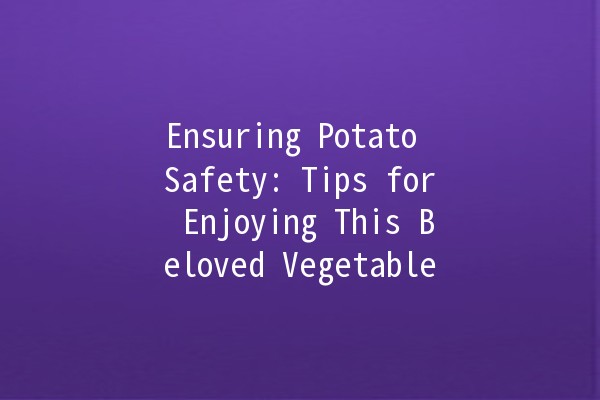Potatoes are one of the most widely consumed vegetables worldwide. They are versatile, nutritious, and a staple in many diets. However, ensuring their safety before consumption is essential to avoid health issues. In this article, we'll delve into potato safety, providing you with practical tips and techniques to enjoy your potatoes safely, whether you grow them at home or buy them from stores.
Understanding Potato Safety
When shopping for potatoes, it's vital to select highquality tubers. Here are some key indicators to look out for:
Skin texture: Choose firm potatoes with smooth skin. Avoid those with wrinkles, cuts, or blemishes, which can indicate spoilage.
Color: Potatoes should have a consistent color. If you see green spots, this indicates the presence of solanine, a naturally occurring toxin.
Sprouting: If your potatoes have started to sprout, don't panic—it's still safe to eat as long as you remove the sprouts.
Practical Application:

When at the grocery store or farmer's market, take your time to examine the potatoes. Check for firmness and signs of spoilage, and avoid purchasing any that appear damaged.
Potatoes should be stored correctly to prolong their freshness and prevent bacterial growth.
Temperature: Store potatoes in a cool, dark place, ideally between 45°F to 50°F (7°C to 10°C). Avoid placing them in the refrigerator, as this can convert starches to sugars leading to a sweet taste and undesirable texture.
Ventilation: Use a paper bag or a basket with holes for ventilation to keep potatoes dry and free from moisture, which can lead to rot.
Practical Application:
Create a dedicated storage area in your kitchen or pantry for potatoes, ensuring it's cool, dark, and wellventilated. Regularly check on your potatoes, discarding any that show signs of rot.
Before cooking, make sure to wash your potatoes thoroughly to eliminate dirt and bacteria.
Washing: Rinse them under running water and scrub the surface with a vegetable brush to remove any pesticides or soil.
Peeling: If you're peeling potatoes, do so with a clean peeler. Always use a clean cutting board and knife.
Practical Application:
Make it a habit to wash all vegetables, including potatoes, before using them in your meals. This practice helps reduce the risk of contaminating your dishes.
Cooking potatoes properly is crucial to eliminate any potential pathogens.
Cooking Methods: Boiling, baking, roasting, or frying are all suitable methods. Make sure that the internal temperature of the potato reaches at least 165°F (74°C).
Avoiding Overcooking: While cooking, be cautious not to overcook potatoes, as this can convert them into mush and may increase the glycemic index, which is not ideal for those monitoring their blood sugar levels.
Practical Application:
Use a food thermometer to check the internal temperature of the potatoes. This ensures they are cooked thoroughly and safely, reducing the risk of foodborne illnesses.
Potatoes are generally safe for most people; however, some individuals may have sensitivities or allergies.
Common Issues: Some people may experience gastrointestinal distress after consuming potatoes, possibly due to solanine or nightshade sensitivity.
Potato Preparation: For those with specific dietary concerns, opting for organic potatoes can reduce exposure to pesticides and chemicals.
Practical Application:
If you or someone you cook for has known food sensitivities, always prioritize sourcing organic potatoes and consult with a healthcare professional for tailored dietary advice.
Frequently Asked Questions
Potatoes can spoil if they are stored improperly. Look out for these signs: dark spots, soft texture, and unpleasant odors. A sprouted potato is not harmful but should have sprouts removed before cooking.
A green potato contains solanine, a toxic compound that can cause nausea and headaches when consumed in large quantities. It's advisable to peel off the green parts, but if the potato is extensively green or has a bitter taste, it's best to discard it.
Fresh potatoes should be firm with smooth skin and lack any signs of sprouting. If they feel soft or show any signs of decay, they're no longer fresh and should be discarded.
No, refrigerating potatoes can lead to changes in taste and texture due to the conversion of starches to sugars. Instead, store them in a cool, dark, and dry place.
Yes, potato peels are safe to eat and contain many nutrients. Just ensure they are washed thoroughly to remove any dirt or contaminants before consumption.
Boiling or steaming potatoes is often recommended to preserve their nutrients. Avoid frying, which can add unnecessary fats and calories.
In summary, ensuring the safety of potatoes involves understanding how to select, store, wash, prepare, cook, and recognize spoilage. By following these practical tips, you can enjoy the nutritional benefits of this versatile vegetable while minimizing health risks. Embrace proper potato handling techniques, and enhance your culinary experiences with delicious, safetoeat potatoes!